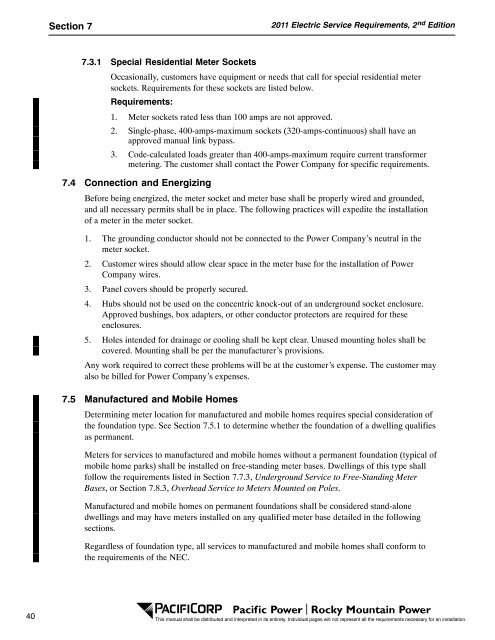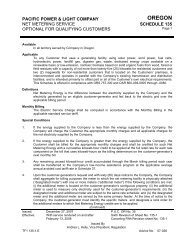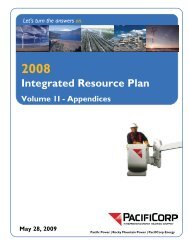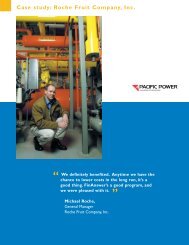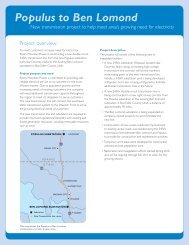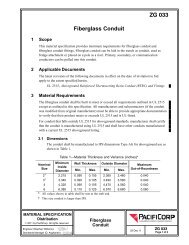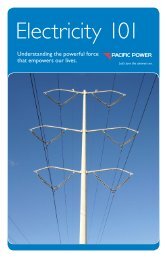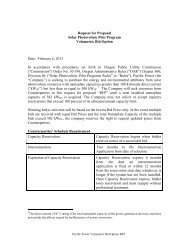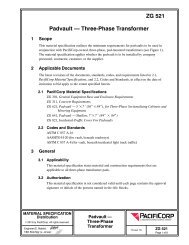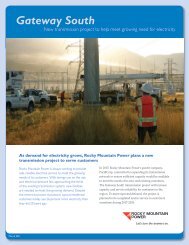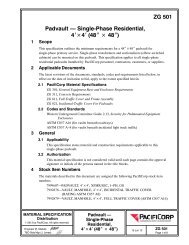2011 Electric Service Requirements Manual, 2nd - Pacific Power
2011 Electric Service Requirements Manual, 2nd - Pacific Power
2011 Electric Service Requirements Manual, 2nd - Pacific Power
You also want an ePaper? Increase the reach of your titles
YUMPU automatically turns print PDFs into web optimized ePapers that Google loves.
Section 7<br />
<strong>2011</strong> <strong>Electric</strong> <strong>Service</strong> <strong>Requirements</strong>, 2 nd Edition<br />
7.3.1 Special Residential Meter Sockets<br />
Occasionally, customers have equipment or needs that call for special residential meter<br />
sockets. <strong>Requirements</strong> for these sockets are listed below.<br />
<strong>Requirements</strong>:<br />
1. Meter sockets rated less than 100 amps are not approved.<br />
2. Single-phase, 400-amps-maximum sockets (320-amps-continuous) shall have an<br />
approved manual link bypass.<br />
3. Code-calculated loads greater than 400-amps-maximum require current transformer<br />
metering. The customer shall contact the <strong>Power</strong> Company for specific requirements.<br />
7.4 Connection and Energizing<br />
Before being energized, the meter socket and meter base shall be properly wired and grounded,<br />
and all necessary permits shall be in place. The following practices will expedite the installation<br />
of a meter in the meter socket.<br />
1. The grounding conductor should not be connected to the <strong>Power</strong> Company’s neutral in the<br />
meter socket.<br />
2. Customer wires should allow clear space in the meter base for the installation of <strong>Power</strong><br />
Company wires.<br />
3. Panel covers should be properly secured.<br />
4. Hubs should not be used on the concentric knock-out of an underground socket enclosure.<br />
Approved bushings, box adapters, or other conductor protectors are required for these<br />
enclosures.<br />
5. Holes intended for drainage or cooling shall be kept clear. Unused mounting holes shall be<br />
covered. Mounting shall be per the manufacturer’s provisions.<br />
Any work required to correct these problems will be at the customer’s expense. The customer may<br />
also be billed for <strong>Power</strong> Company’s expenses.<br />
7.5 Manufactured and Mobile Homes<br />
Determining meter location for manufactured and mobile homes requires special consideration of<br />
the foundation type. See Section 7.5.1 to determine whether the foundation of a dwelling qualifies<br />
as permanent.<br />
Meters for services to manufactured and mobile homes without a permanent foundation (typical of<br />
mobile home parks) shall be installed on free-standing meter bases. Dwellings of this type shall<br />
follow the requirements listed in Section 7.7.3, Underground <strong>Service</strong> to Free-Standing Meter<br />
Bases, or Section 7.8.3, Overhead <strong>Service</strong> to Meters Mounted on Poles.<br />
Manufactured and mobile homes on permanent foundations shall be considered stand-alone<br />
dwellings and may have meters installed on any qualified meter base detailed in the following<br />
sections.<br />
Regardless of foundation type, all services to manufactured and mobile homes shall conform to<br />
the requirements of the NEC.<br />
40<br />
This manual shall be distributed and interpreted in its entirety. Individual pages will not represent all the requirements necessary for an installation.


